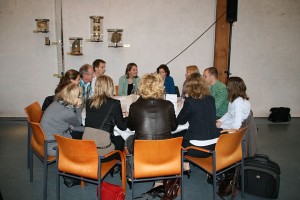
I'm currently facilitating two learning trajectories, both starting online. I'm a big fan of starting online because everybody can start at his/her own pace and there is space for everyone to express him/herself (I actually learned this practice from
CPsquare). Another recent experience is that I was skyped into a training in Cambodja for a session about
online advocacy. It was my second time of being skyped into a session, the first time it felt like talking to a wall, but this time I even had the feeling I had some contact with the group. I asked them questions and they answered by raising their hand. The trainer counted and summarized. At the end they also asked questions, passing the mike of the headset, which worked pretty well. Here you see a picture. For people who like the technical details: we combined
Zipcast en
Skype. Zipcast allowed me to show the slides and dictate the pace. The sound of the Zipcast was not good enough so we combined it with skype.
Both experiences made me reflect on how big the shift is for trainers and facilitator who embrace social media and integrate in in their practice. I can see some emerging new practices which are not widespread yet. Online learning exists for a long time already. However, online learning was mainly elearning as individual online modules and had nothing to do with classroom training. Elearning and classroom training were two separate 'things'. Now with the widespread use of social media, elearning2.0 as you might call it, has come under the control of facilitators/trainers. However, making use of this potential as facilitator requires a huge shift in practices. Based on my own experiences, I'd say facilitators who want to leverage the opportunities offered by social media need to adopt the following practices:
Select and manage your own tools. With elearning- in the sense of individual online learning modules- design and implementation is done by an instructional designer and some IT-support. Working with Learning Management Systems, there is often a more technical person involved in the design and implementation of the platform which alienates the technical design from the design of the learning process. With social media, there are so many free and easy tools, which has given facilitators the control over the tools. It is easy to set up a
wiki,
facebook group, a
Yammer community or
Ning social network. Or start your own
zipcast- you don't need expensive webinar software. Even when organisations offer tools which do not suit what you want, you can set up your own toolset. To do this effectively however, facilitators need to know those tools and to be able to make a good selection.
Weave online and face-to-face activities into a powerful, mutually reinforcing blend (hence design longer trajectories). I think there is already an important trend moving from one-off training events to longer learning trajectories. Online hasn't always found its right way into the blend. I've observed that people have different ideas about what's best to do online and what kind of learning activities fit best face-to-face. Some are convinced all presentations should be done online, so that you can use face-to-face for interactions. I'm not sure whether a '
this is best done online' or '
that is best done face-to-face' exists. I've experienced that it is powerful to sandwich topics. Start online (or face-to-face) and continue to deepen them in another modus. What's for sure is that the design of blended trajectories is a new field for most trainers and new practices will have to develop over time. There are lots of blended experiences but not many trainers yet who master a systematic design of blended trajectories.
Be prepared to understand and support real problems and practice dilemmas. Tailor-made. When you start adding online activities to the mix, you will see that there is ample space and time for people to express their questions, doubts, thoughts and experiences. You will notice that you get much closer to the actual problems and workplace-based questions of the participants. This means for a facilitator or trainer, it will not be enough to have a standard tool and exercise and take your participants through the flow, but you will need to prepared to understand their issues and respond in a tailor-made way. Take the example of a teambuilding session. If it is a one day session, you do an exercise to let the team reflect on their collaboration, their styles, give feedback to eachother. But the real effect of the exercises will surface after some time when the team is back to work. Continuing online with the team creates an opportunity for real (and longer!) support to the teambuilding process, but it also demand a deeper understanding, wider skillset and motivation from the facilitator.
Be available 24/7. Continuous partial attention. This may be the reason why not many trainers have made a real shift. A training can be neatly blocked in the agenda. Working online with a group, however, you have to be flexible and devote some continuous partial attention to the proces. If you are still immersed in a full trainings schedule, it may be hard to make this shift. One of the solutions may be to work more often in small teams of facilitators.
Open your boundaries. In the classroom training setting, it is clear who is in and who is out, there is a trainer and there are trainees. The trainer is in front of the group, the trainees are not (except in some exercises). Using social media this boundary becomes more fluid, there are no longer 'walls', anybody with an internet connection can participate. Online, you may invite additional people in the role of expert, interested colleagues, supervisors, mentors, guests or inspirators. This automatically changes the fixed roles from 'trainer' and 'trainee' to a more dynamic scene with various players. Everyone can bring in knowledge and expertise. Which brings me to the next one:
Bring expertise into your training.
You have to think out of the box (and out of the country!) and think of possible
expert inputs for your trajectory, which you can bring in through webinars, skype sessions or through asynchronous discussions. In the case of the Cambodja training I
knew the trainer personally and she arranged for my input, she is
definitely an out-of-the-box person. Many trainers act like the expert,
bring in a colleague or only facilitate processes without bringing in
expertise. Facilitating process is important, but offering training without
expertise input does not work for the participants who value expertise inputs. Distance
is no longer an excuse!
Pay attention to social learning and building social capital. And last but not least: working with social media means fostering interaction. Social media are about online interaction. This means that collaborative learning and sense-making are important. Hence it is logical that the facilitator also understands social learning processes and knows how to work with those processes. This means taking a relational approach into account. I have the impression many trainers do that already in their training sessions, but not really consciously.
Curious to know whether you recognise these practices and whether you are already applying them too?
 First let's talk about my bicycle (that's how my first blogpost started though you can see how my bicycle changed!). In november my accelerators broke down. First I felt like I was peddling like crazy.. But it took me a long time to make an appointment for repairs (for several reasons: bicycle repair shop had disappeared etc.). So after one month it seemed like completely normal to pedal in first gear only, I had completely gotten used to it.
First let's talk about my bicycle (that's how my first blogpost started though you can see how my bicycle changed!). In november my accelerators broke down. First I felt like I was peddling like crazy.. But it took me a long time to make an appointment for repairs (for several reasons: bicycle repair shop had disappeared etc.). So after one month it seemed like completely normal to pedal in first gear only, I had completely gotten used to it.










